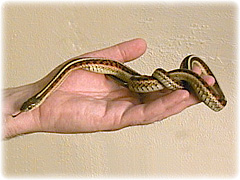Garter Snake
Revision as of 18:02, 18 March 2010 by Cporteous (talk | contribs) (Created page with '{{unfinished}} 250px|thumb|right|'''Garter snake''' ©RVC and its licensors, Peer Zwart and Fredric Frye. All rights reserved ==Introduc…')
| This article is still under construction. |
Introduction
Garter snakes (Thamnophis spp.) are in the subfamily Natricinae of the family Colubridae and are extremely common pet snakes. They are very agile and live between three to 10 years in captivity.
Morphology
They may attain over a metre (4 ft) and characteristically have three yellowish lateral stripes and a double row of spots between the stripes but the morphology is extremely variable.
Free-Living
- Distribution – The common garter snake (T. sirtalis) is the most widely distributed snake in North America.
- Habitat – Garter snakes are found in woodlands, marshes and near rivers. They are crepuscular or diurnal and warm by basking.
- Diet – Garter snakes are not constrictors but overcome their prey by jaw power. Free living garter snakes eat fish, amphibians, earthworms and insects. The eastern species of garter snakes seem to prefer earthworms and frogs in the wild, whilst the western species tend to be fish eaters.
Captivity
- Cage – A glass aquarium/vivarium of about 75 x 37 x 30 cm (36" x 15" x 12") is adequate. The height is not critical but a large area allows the active snakes room to move around. A pool of some description should be provided. Adequate ventilation must be provided since excessive dampness and the inability to get completely dry can cause disease. Garter snakes especially need secure quarters!
- Temperature – Garter snakes require a daytime temperature of about 25° to 30°C falling at night to 24° 26°C. A temperature drop for up to three months between November and February stimulates
reproduction.
- Diet – Young garter snakes may be difficult to rear but will eat chopped whole fresh-water fish and earthworms. Adults should be fed three to four times each week. Commercial food such as "Garter Grub" is available.
- Reproduction – Garter snakes are viviparous and can be bred from two to three years of age. They may breed twice a year. Litter sizes usually number 10 to 30 (although much higher are recorded). The young are born in the late summer and average over 20 cms in length. The young eat frequently to fatten up before the winter hibernation.
- Veterinary considerations – Garter snakes are often presented with neurological signs due to
hypothiaminosis because of their inappropriate diet.
